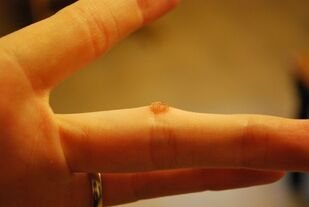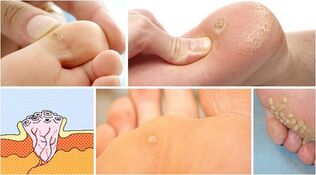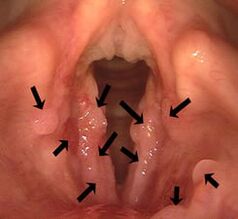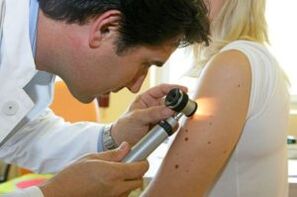Papillomas are benign tumors that localize to the skin and mucous membranes. They are derived from the activation of human papillomavirus (HPV) and are of many types. Some of them are harmless and cause only a cosmetic defect, others are potentially dangerous and can develop into cancerous tumors.
Mechanism of papilloma formation
The appearance of a particular type of neoplasm depends on the type of virus patient. A distinction should be made between low oncogenic strains in which growths do not pose a major threat to the carrier and highly oncogenic strains. Neoplasms appear due to the papillomavirus, the effect of which leads to excessive cell division, resulting in a gradual increase in growth.
"Safe" papillomas usually occur on the skin, while the most alarming ones are localized in the mucous membranes.Such tumors are usually caused by a highly oncogenic type of virus. For women, growths in the genital area can be dangerous for cervical cancer.

Common Papillomas (Warts)
One of the most common manifestations of HPV, commonly known as "warts. "Their appearance is usually due to the effect of low oncogenic strains mediated by contact and daily life.
Warts usually occur on the fingers, palms, soles, or feet.
Externally, they resemble small papillary neoplasms with a homogeneous structure. Ordinary papillomas are soft to the touch, their pigmentation is weak at the beginning of the disease: the color is practically no different from the color of the body.
However, as the disease progresses, the growth increases and begins to darken. Sometimes the eye can grow in the middle of the wart.
Filiform papillomas
This type of papilloma is named for its small legs, which cause the neoplasm to rise above the surface of the skin. The growth is characterized by an elongated shape, about 5 mm in size. Papillomas are most commonly located in areas with the thinnest skin:
- chest;
- neck;
- eyelids; lumbar region
- ;
- armpit.
Filiform papillomas are more common in patients over 45 years of age, but sometimes occur in young people.Growth usually increases as the disease progresses.They are gradually stretching more and more.
The head of the papillomas is yellow or pink, with no pronounced pigmentation. Keratinized neoplasm is rare. With trauma, no pain is observed. Several may also appear at the site of the damaged filiform papilloma. If the growths are on the face, it is recommended to stop using the scrub or brush. Papillomas in the armpit area are also often wounded by razors, which can adversely affect the patient’s health.

Flat papillomas
This form of papilloma is also localized on the skin and resembles tiny plaques. Flat papillomas have a yellowish tinge, their size does not exceed 1-2 mm. In its structure, the growths are dense, their roots are located under the skin. This can cause pain during damage or pressure. This structural feature sometimes leaves scars after removal of the buildup.
Typical symptoms of flat papillomas:
- redness of the skin around the growth;
- itching;
- tactile pain;
- inflammation.
Growths usually appear on the face or hands, but sometimes on the genitals. In women, they are usually located on the big lips, in men, on the scrotum or anus. Flat papillomas grow rapidly in size and bleed traumatized.
Sexual warts

These growths are usually located in the groin or mucous membranes. They only cause HPV strains that occur during unprotected sex. Most commonly hit:
- sleeve;
- vulva;
- cervix;
- anus area;
- scrotum;
- penis.
The growths are similar to thin papillae, small - 2-3 mm. In general, the virus is not limited to the appearance of a single neoplasm. Warts are characterized by multiple growths appearing simultaneously, gradually merging with each other. Neoplasms grow and grow rapidly. Then their shape begins to resemble the cauliflower inflorescence.
Genital warts are considered to be one of the most dangerous types of papillomas.In addition to being able to progress to malignancy, these growths are often accompanied by infection. In addition, neoplasms tend to relapse after removal, so patients should undergo regular examinations to control HPV levels.
In rare cases, condylomas may develop on the internal organs, such as the walls of the stomach or rectum. In this case, it is impossible to diagnose the presence of the neoplasm on its own. The lack of specific symptoms can become a problem in diagnosing and treating the disease.
Lewandowski-Lutz papillomas
A rather rare type of papilloma. They most commonly occur on the feet and hands. The distinguishing feature of the outgrowths is the uneven edges. They are usually brown in color, but can sometimes have a dark red hue. This form of the disease can also contribute to the degeneration of neoplasms into malignancy, so patients should seek medical attention as soon as possible.

plantar warts
These increases are more common in children and adolescents and are rare in adulthood. It is considered a common reaction of the body to a decrease in immunity, which is accompanied by trauma to the sole due to uncomfortable shoes. Unlike common calluses, the wart is rough and has uneven edges. In addition, the skin pattern is clearly visible on the callus.
Plantar warts are characterized by a small patch on the surface of the skin and a large base growing subcutaneously. It is usually completely keratinized due to constant wear and tear during walking. Over time, the growth increases, squeezing or touching causes discomfort and pain.
Due to the nature of the structure, it is difficult to remove the wart from the skin as most of it is located inside. Therefore, after removal, it is often necessary to apply stitches and a scar may remain at the procedure site.
Juvenile papillomas
Most infections occur in children under 5 years of age, as the infection usually occurs during childbirth. If a pregnant woman is a carrier of papillomavirus and there are genital warts in the vaginal area, the child is most likely to become infected.

Juvenile papillomas on the skin are not dangerous. However, they can also be localized in the larynx, which can cause the baby to have difficulty breathing. In the initial stage, no signs of the disease were observed. After a while, the following symptoms appear:
- a lot of feeling in the throat;
- difficulty swallowing saliva or food;
- impaired respiratory function.
In older children, a change in tone may occur, which is a characteristic sign of tape damage. Papillomas can grow and trigger asthma attacks, which can one day result in complete cessation of breathing.
Papillomatosis
Papillomatosis is a condition in which the number of neoplasms increases dramatically and spreads throughout the body. It is also called generalized papillomavirus. Usually there is a large accumulation of papillomas in the hands, face, genital area. Papillomatosis in the mucous membranes or internal organs is potentially dangerous to humans.
Papillomatosis is most commonly mentioned when juvenile papillomas appear in the laryngeal region. They are prone to overgrowth.

Conclusion
Although there are relatively safe papillomas, each requires regular testing by a specialist. This helps to control their growth and remove it immediately if necessary. In addition, it is important to note that the presence of neoplasms is an indicator of papillomavirus infection, which also requires timely therapy.























